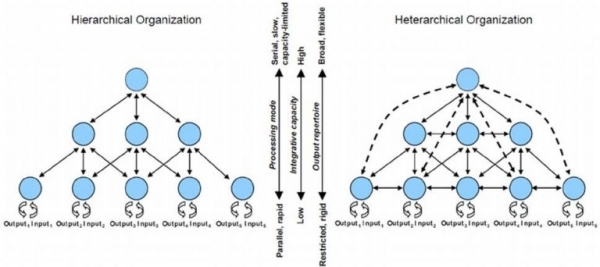What is heterarchy, and why you want it
Not alone, of course. But you want heterarchy. Trust me.

<u><em><strong>CAPTION:</strong>
<a href="https://www.researchgate.net/Hierarchical-and-heterarchical-organizations-A-heterarchy-differs-from-a-hierarchy-in_fig2_254089716" target="_blank">Heterarchical (right) vs Hierarchical Organization (left), click for source</a>
</em></u>
Here is part of a little gem from 2014, called “The CompuServe of Things”. Compuserve was the first major commercial provider of online service in the early 1990s. The part of that post quoted below, with minor edits, explains in a simple way something that should be taught in schools (as does the rest of that post, do read it all), that is the meaning, and relevance of “open Internet”. For every Internet, including the much hyper-hyped Internet of Things.
When we say the Internet is “open,” we’re using that as a key word for the three key concepts that underlie the Internet:
- Decentralization
- Heterarchy (what some call peer-to-peer connectivity)
- Interoperability
Heterarchy would be, says Wikipedia a system of organization where the elements of the organization are unranked (non-hierarchical) or where they possess the potential to be ranked a number of different ways.),
To see how decentralization and heterarchy differ, consider two examples: DNS, the Domain Name Service, and Facebook. DNS is decentralized, but hierarchical. Zone administrators update their zone files and determine in a completely decentralized manner which sub domains inside their domain correspond to which IP addresses (among other things).
But the way DNS achieves global consensus about what these mappings mean is hierarchical. A few well-known servers for each top-level domain (TLD) point to the servers for the various domains inside the TLD, which in turn point to servers for sub domains inside them, and so on. There’s exactly one, hierarchical copy of the mapping.
Facebook, on the other hand, is heterarchical, but centralized. The Facebook Open Graph relates people to each other in a heterarchical fashion—peer-to-peer. But of course, it’s completely centralized. The entire graph resides on Facebook’s servers under Facebook’s control.
Interoperability allows independently developed systems to interact. Interoperability provides for substitutability, allowing one system or service to be substituted for another without loss of basic functionality. As noted above, even though I use GMail as my email provider, I can talk to people who use Hotmail (i.e. they’re interoperable) and I can, if I’m unhappy with GMail, substitute another email provider.
Decentralization, heterarchy, and interoperability are supported by protocol, the standards that govern interaction. One of the ironies of open systems like the Internet is that rules are more important than in closed systems. In a closed system, the hierarchical, centralized authority imposes standards that create order. In an open, decentralized, heterarchical system, the order must be agreed to ahead of time in the form of protocol.
These three concepts aren’t optional. We won’t get the real Internet of Things (me: or a really fair society, for that matter!) unless we develop open systems that support decentralization, heterarchy, and interoperability.
Who writes this, why, and how to help
I am Marco Fioretti, tech writer and aspiring polymath doing human-digital research and popularization.
I do it because YOUR civil rights and the quality of YOUR life depend every year more on how software is used AROUND you.
To this end, I have already shared more than a million words on this blog, without any paywall or user tracking, and am sharing the next million through a newsletter, also without any paywall.
The more direct support I get, the more I can continue to inform for free parents, teachers, decision makers, and everybody else who should know more stuff like this. You can support me with paid subscriptions to my newsletter, donations via PayPal (mfioretti@nexaima.net) or LiberaPay, or in any of the other ways listed here.THANKS for your support!